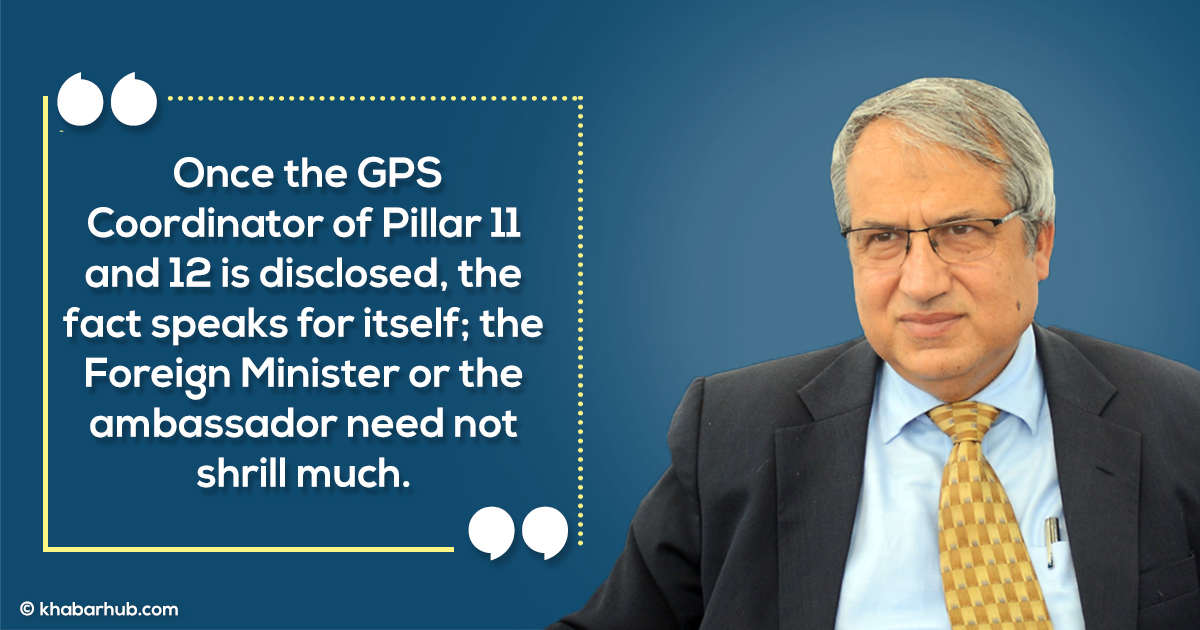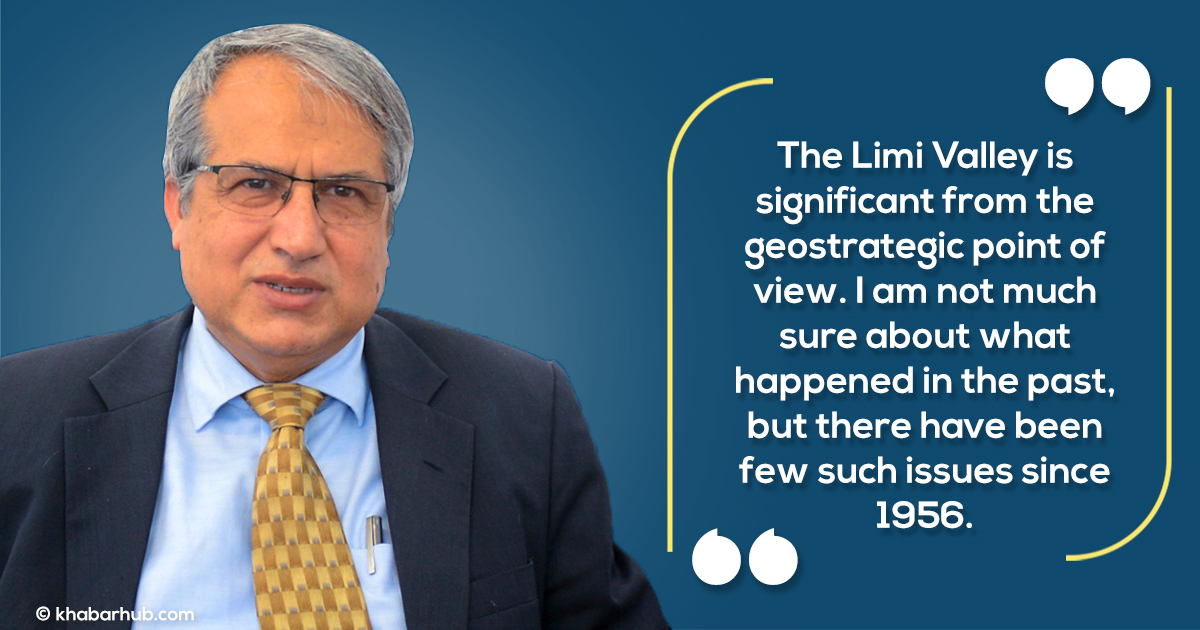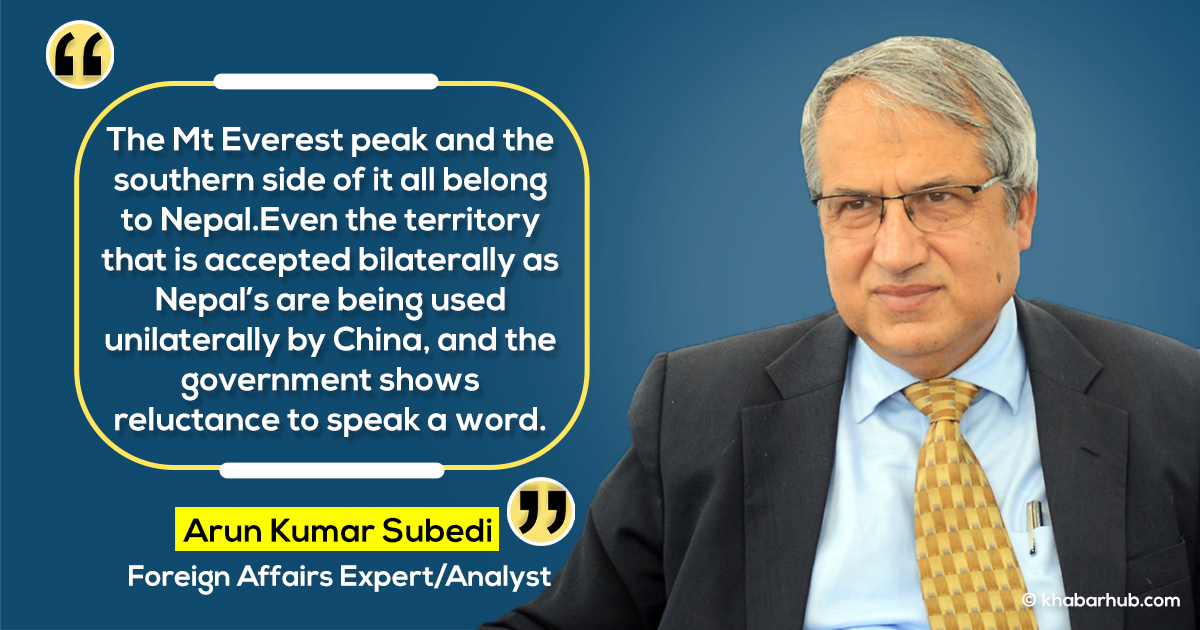The recent issue on border encroachment by China has triggered waves on political and social spectrum of Nepal. Protests were organized against China in Kathmandu. The Government of Nepal has dismissed claims of encroachment of Nepali land by China despite the fact that the locals of Limi, Humla have claimed that the Chinese side has erected nine illegals buildings on Nepal’s land. Khabarhub’s Govinda Luitel had had a candid conversation with political and foreign affairs expert Arun Kumar Subedi on the issue. Excerpts:
What is your take on the disputes related to China’s encroachment of Nepali land and reported construction of illegal buildings on the Nepali land?
The government has already made it clear that the construction made by China is on the Chinese side. The Minister and the ambassador, too, have rejected the encroachment of Nepali land in Humla.
Yet, as the territory of Nepal is the concern of all Nepali people as well; hence every citizen has the right to know on the issue. Strangely, more than the diplomats and the concerned authorities, politicians here tend to talk on border disputes.
Politicians make such issues as a means to entice the voters, hence, often they make a fuss about the issues already addressed and skip the discussion about the issues that might impact their ascent to power.
Yes, there is a border dispute with China. The dispute in Limi has come to the floor now, there is a dispute concerning the Mt. Everest, and there is also a dispute related to Pillar no. 47, among others.
Former ambassador to China Lila Mani Paudel had once stated that China is ready to relocate that pillar.
What do you think is the latest dispute concerning the encroachment of Nepali land in Limi?
Nepal and China signed the last protocol after reaching a conclusion in 1963. During the then Prime Minister BP Koirala’s visit to China and the reciprocation visit of Chinese Premier Zhou Enlai, there had been a discussion on this issue incorporating it as a point of reference.
Prior to this, China had included Mahalangur Himalayan range in its map. It had then claimed that as the monk of Syangboche monastery is a Tibetan, China could claim up to it.
Prime Minister BP Koirala then talked to Zhou Enlai and Mao Tse Tung on the issue convinced both of them with logics and facts supporting Nepal’s claim.
After this, around 21 grazing fields, a village of Mustang and Mt. Everest were located on the Nepali side. Soon the Koirala-led government was dismissed by King Mahendra which delayed the treaty that was otherwise at hand. It remained in narration alone.
The treaty of 1961 signed under King Mahendra’s regime has not changed much of the points of reference made during BP Koirala’s time.
During an interview with Kishori Raman Rana, then Editor of the Kalpana, Chinese Premier made it loud and clear that the Everest peak and the Southern part of it belong to Nepal while the northern part belongs to China.
At the same time, the map and altitude locating 79 pillars were also prepared. There was no mention of latitude and longitude then, there was no GPS.
Based on the point of reference, it was agreed that Pillar no. 1 would be in Tinker separating the northern slope from the southern slope.

There is no mention of the zero number. Pillar 11 is in Taku Lekh at an altitude of 5,202 meters. After that is Pillar 12. The established facts regarding the border say that the pillars have to be in a straight line of 180 degrees.
Limi lies between Pillar 11 and Pillar 12. Maybe from 1979, we started working on border demarcation with India and China forming a joint task force.
How are the border pillars lying in the border with India and China determined?
There were 211 pillars with India. Later, a protocol was prepared including a strip map and the GPS Coordinate of 853 pillars from Kanchanjungha to Garbyang.
The protocol was signed in 2007 when incumbent Prime Minister KP Oli had signed when he was the Foreign Minister.
There are issues related to disputed parts. It has also mentioned various local disputes and the major disputes as in 62 km of the Kalapani area and Susta.
Interestingly, the GPS Coordinate of all 853 pillars lying along the Nepal-India borders is determined under the Differential Global Positioning System (DGPS) Survey.
These pillars are not like moving pillars as depicted by the protestors in the streets of Kathmandu and Maitighar Mandala or TV or other media.
If any of them get damaged or destroyed, they can be relocated easily. On the Chinese border also, the protocol includes the GPS Coordinate of 100 pillars (79 main pillars and 21 additional pillars).
There is no mention of GPS Coordinate in the protocol signed in 1963; no other protocol has been signed afterward.
As Nepal has already prepared a strip map with the GPS Coordinate of all 100 pillars, it can easily be found out how far the border goes actually.
This is quite strange that the ambassador and the Foreign Minister are making comments in haste without consulting the document the government owns. Our government has already said that our land has not been encroached upon.
Yes, the government has said so, but the concern is on what basis the government has said so. It should tell what the GPS Coordinate of Pillar 11 and Pillar 12 are.
The GPS Coordinate of the pillars and the straight-line principle of the border will make it clear where actually China’s recent construction lies. This is something a technician at the Department of Survey can do.
Why is our government unwilling to publish the GPS Coordinate of out border pillars? Has China encroached land at Limi as it has come in the media? What do your research and the facts establish?
First of all, the fact to establish is to find out whether Pillar 11 has been shifted. Or has it been reconstructed?
The facts and evidence should establish such things. The GPS Coordinate of Pillar 11 and Pillar 12 has to be discovered first. This resolves all the complications.
However, provided China and Nepal keep the pillar coordinate confidential, it gives birth to skepticism on their intent.
What makes one feel foul is also the fact that the construction of these buildings resumed after the Chinese President’s historic visit to Nepal.
Has the government kept mum on the dispute or it’s grown indifferent deliberately?
This is an issue related to strategy. The Limi Valley is significant from the geostrategic point of view. I am not much sure about what happened in the past, but there have been few such issues since 1956.
When there came the proposal of letting India establish a security post in Kalapani in 1956, then Prime Minister Tanka Prasad Acharya defied it.
The proposal was taken to King Mahendra, later getting a nod from the King, the security post was allowed in the Kalapani area.
The permission was not for the army, it was meant for the border security force. This matter remained confidential during the Panchayat System.
The treaty and the letter of exchange between the King and Indian authority are not brought to the public till now.
The way the ruling Nepal Communist Party (NCP) and the public behave in a pro-Chinese way, and the way both are mounting pressure on India or the disputes related to India makes one feel that there could be a ‘confidential’ deal at the top level which could have paved room for such transgression.
Locals of Limi, however, claim that the territory has been encroached there.
Yes, what the locals say matters as well. Yet, the nation has different parameters to decide. However, the Nepal government has to issue the GPS Coordinate of the pillars lying in both the Indian and Chinese border.
Even if China does not agree, Nepal has to issue it. If we can issue the map including the parts missing before as in Kalapani, Limpiyadhura, Lipulekh case, we should manage to issue GPS coordinates of the pillars towards China.
What is the way out to resolve the border dispute? Is it in the protocol?
Since the inking of the protocol in 1963, the only dispute that arose between Nepal and China had been the Sagarmatha.
China refers to the peak of Sagarmatha as the border point. But the agreement signed during Prime Minster BP Koirala and King Mahendra does not refer to it as such.
It’s not even regarded as the point of reference. Whether it’s the interview the then Chinese Premier gave to Kishori Rana or the Peking Review of the time, they describe Sagarmatha as Nepal’s.
Zhou Enlai has reiterated that the Everest peak and the southern side of it all belong to Nepal. Chen Yi, the Chinese Foreign Minister (1958-72), has also echoed Premier Zhou Enlai. King Mahendra has also claimed so.
It’s all documented. Nepali Congress, the main opposition party in parliament should have raised the issue, but the opposition party seems in deep slumber like the legendary character Kumbhakarna (a character in Ramayan) whereas the ruling party has abstained itself from genuine issues like another legendary demon Ghantakarna.
The public and the scholars, they are hardly heard by anyone.
What’s China’s fuss about Sagarmatha now?
Now, China has started regarding the Sagarmatha peak and the northern part as its border point. Climbers currently have been reaching the highest peak of the world from the Chinese side as well, but it was not so before.
However, the treaties of 1960 and 1962 hail Sagarmatha and the southern part as solely ours i.e. Nepal’s. China has defied it, now.
My query is what’s the basis of China’s aggression? Which letter of exchange or protocol allows China to do so? In this sense, I say the main opposition party here has become Kumbhakarna, the demon known for deep slumber and the ruling party has become Ghantakarna, who disregards and abstains everything good and smashes and damages everything for its personal benefit.

Now China has measured the height of Sagarmatha. The 1963 Protocol hails that any dispute on the border or other border activities have to be settled through a border survey team consisting of an equal number of representatives from both nations.
However, there is no idea to the public here, whether such a team has been ever formed. Sagarmatha peak is ours. This government if it feels has some accountability to the public has to let all Nepalis know about such issues.
Why do you think the government has kept mum about the Chinese activities in Sagarmatha?
I feel embarrassed and ashamed at the dual standards of the incumbent government as it bugles the pillars on Indian sides have been moving here and there (whereas the fact is that provided the government wants it can easily find out the truth using GPS Coordinate used in pillars).
It shows an unwillingness to request for GPS Coordinate in pillars in Chinese borders and also to request China to abide by the signed treaties.
Even the territory that is accepted bilaterally as Nepal’s are being used unilaterally by China and the government shows reluctance to speak a word. I feel ashamed at this strange submissiveness.
Like Limi and Sagarmatha, are there other places where there have been border disputes with China?
There are not many places of a dispute with China, but there are many places which are of special strategic importance to China.
The Limi Valley, for instance, makes one fear that China might grow further possessive about such places of strategic importance in Nepal.
Lipu Lekh Pass is under India’s control, yet, that’s in Nepal’s cartographic presentation. China has its interest in that place as well.
In Urau pass and the road over there also China is interested deeply. It knows very well that coming to Baitadi Patan and Khaptad Plateau from Urau pass intense strategic pressure can be mounted against India.
Now, it’s clear that it had long set its eyes on the Limi Valley. China has an interest in Lhomanthang as well. Lhomanthang has a pass at an altitude of 4,600 meters.
We have an unusual border at Kerung as well. China is interested in offering a train track and road network from Kerung which lies at the altitude of 5,200 meters but is reluctant to let Korola pass route into operation, do you know why?
It’s because the settlement of Rasuwa lies below the road whereas the Chinese side lies above the route in Kerung; however the Chinese settlement lies below from Lhomanthang.
China, since long has shown interest in Lhomanthang and Dolpa plateau. There are many valleys in Limi. From there more pressure can be mounted against India from Khaptad, Baitadi Patan, Sisne Himal.
There have been Chinese interests in Tamor valley in the east. In the Southern hills from Dharan to Bhedetar, there can be Chinese interest.
We have involved the Chinese side in various projects in those areas. This is worth considering. We are linking the Tamor corridor to China. Considering the conflict between India and China, Nepal is an easy point for China to offense whereas strategically India might have to be more defensive from Nepal.
Do you mean, there are more places of strategic importance to China than to India in Nepal’s border with its neighbors?
Yes, strategically, China has more interest than India. I do not know much about geological importance. There is a uranium issue in Lhomanthang.
Some of the geological issues have to be kept confidential, but we often organize press conference on such issues as well.
In the case of Limi, it’s said that the government was too quick to respond. What could be behind such a response?
Yes, such a quick nod in such serious issues raise many questions. Instead of considering the facts, why is the government so impatient to be so submissive? It could be for political gain.
There had been a dispute over the same issue 3 years before. A team had visited the site and prepared a report, but the report was not published.
Once the GPS Coordinator of Pillar 11 and 12 is disclosed, the fact speaks for itself; the Foreign Minister or the ambassador need not shrill much.
The main opposition has spoken slightly on it. The government should dare to publish the GPS Coordinate of pillars in the borders on both sides. To cause anarchy provoking people and spoil foreign relations is also the treason against the nation.
Do you think the government is somehow inclined to China irrespective of the need to maintain diplomatic balance?
International polarization has changed its course after the COVID-19 outbreak. Personalities such as Indian Prime Minister Narendra Modi have to retreat due to this pandemic.
Nepal also seems to be losing its balance. It seems inclined toward China. Nepal’s economic geography is not much close to China.
The supply system is not linked to China as well. We should consider where our population is inclined to, where our economic, social and other interests are closely related most.
Obviously, such closeness is with India. Our monetary monitory economics is pegged with India. We should consider military interest as well. No diplomacy and neighbor policy runs smoothly ignoring such factors.
As a scholar on international relations, what is your recommendation to the Nepal government?
Besides preventing Nepal from being used against China, we cannot do much to China. Our national interest, international politics and internal affairs are closely connected to India, the USA, and the Gulf countries.
Our interest is also dependent on Japan, South Korea and Australia as well. Irrespective of these interests, and ignoring such factors we cannot prefer to be pegged and pet state of China.









Comment